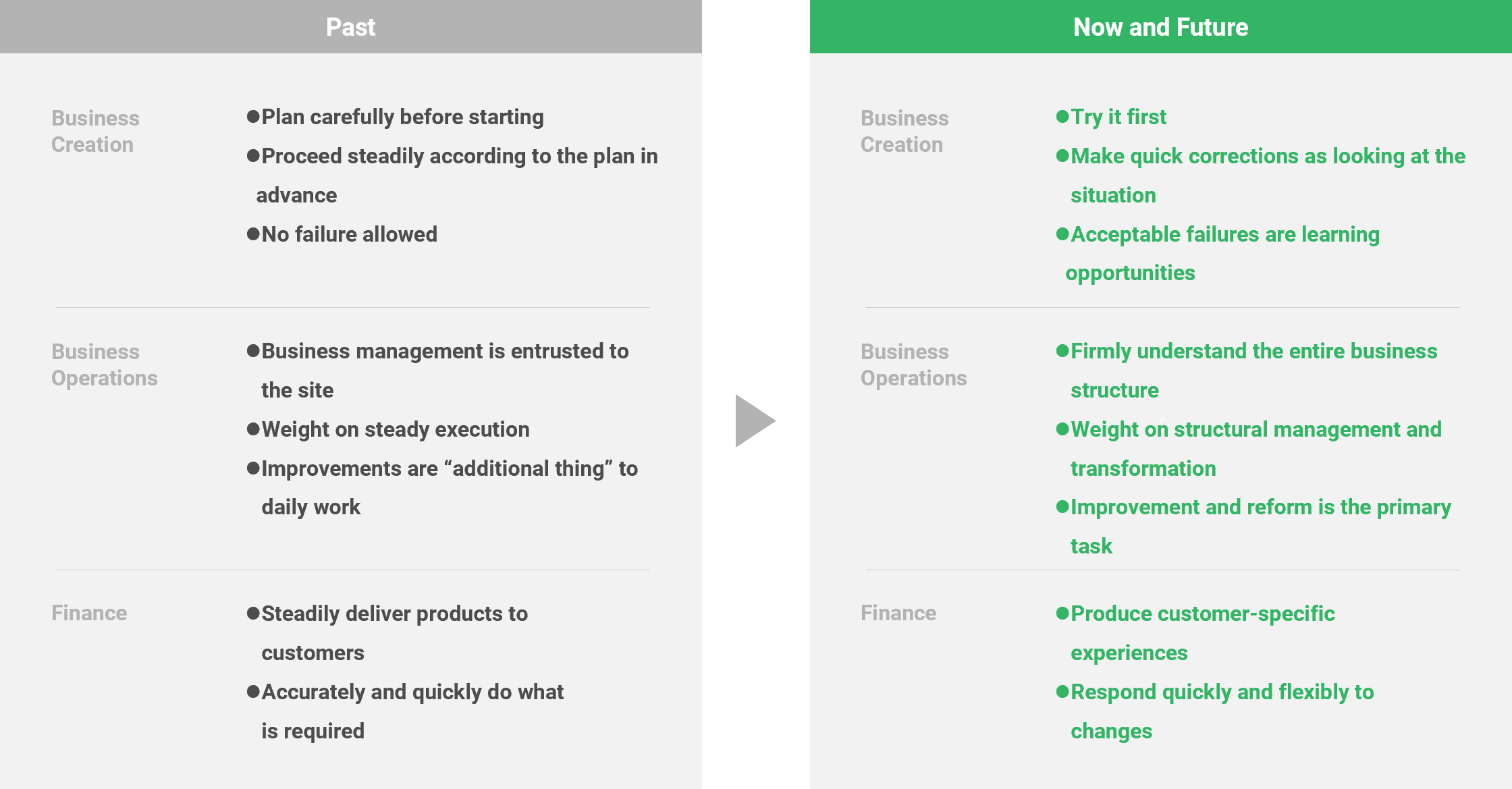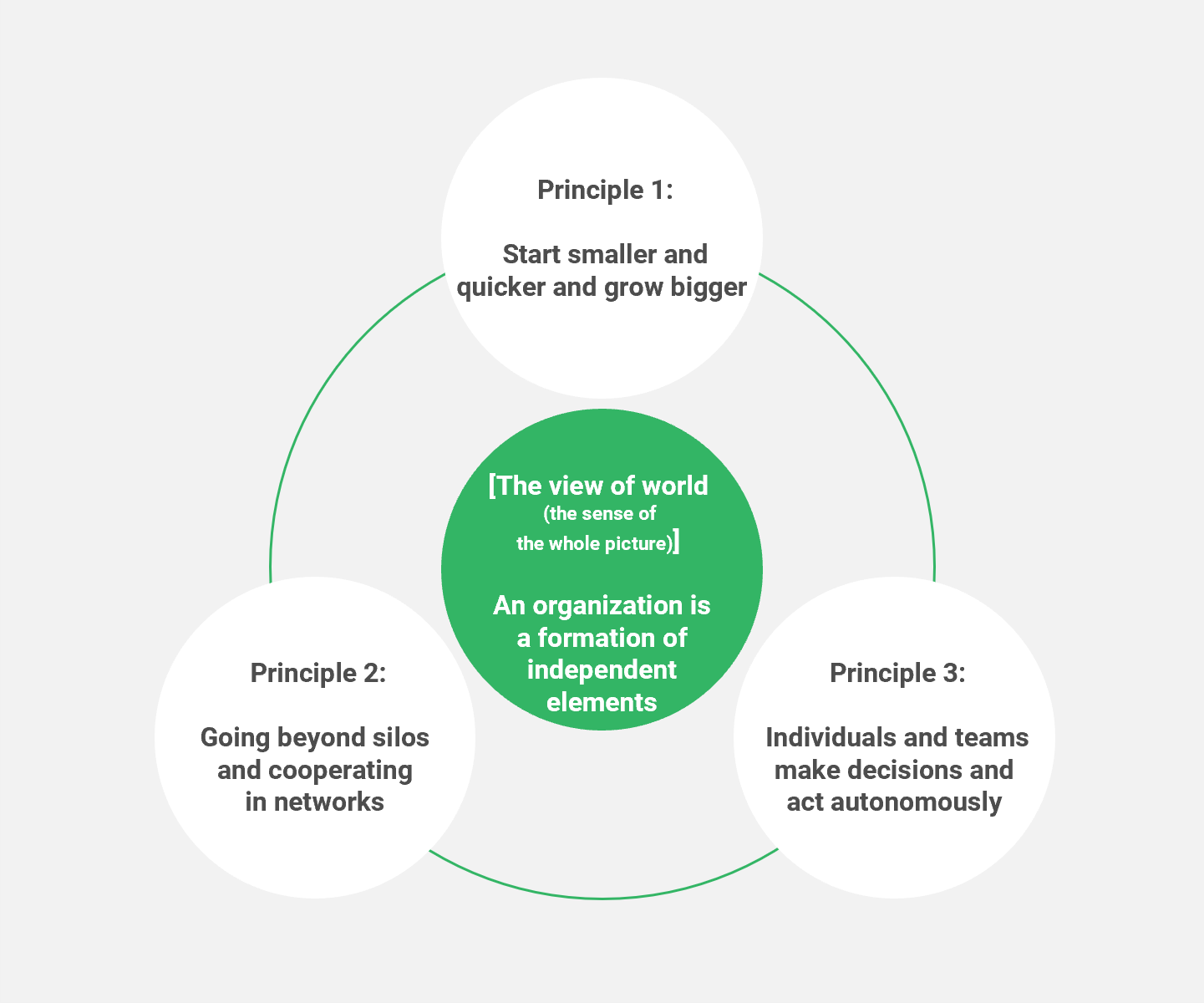SERVICES
The important themes for transformation that LTS considers
Business agility is a term that refers to organizational capabilities that enable companies to adapt quickly the changes in the external environment. This new term of power is now attracting attention in order for companies to grow continuously in an uncertain business environment.
Business agility “before” and “after”

[The view of world (the sense of the whole picture)] An organization is a formation of independent elements

It was Agile Software Development (Agile development) to have spread the idea of agility to the whole business. In agile development, the software to be developed is broken down into detailed functions, and the minimum necessary items are created and released according to their priorities.
The concept established by agile development is now applied not only to software development but also to various activities in corporate operations, and is a concept that should be called the basis of agility.
Promoting the concept of “quickly creating the minimum necessary items” requires the people in charge of various fields (business leaders, related department leaders, engineers, legal and security experts, etc.) to work together.
Until now, the majority of companies have been organized by function (by specialty) and functional silos. From now on, it will be important for people with completely different specialties to gather in one team and to understand and respect each other’s specialties. Various foundations are required, such as an evaluation system centered on contributions to the team and learning regularly to understand each other’s specialties.
In today’s business environment, where a sense of speed is required, valuable time is wasted while information flows back and forth between the and management. In addition, as business structures become more complex and customer preferences are becoming more segmented, it is becoming more difficult for managers to process all management information. Inevitably, at various sites, the person in charge is required to make decisions and act on their own, rather than asking superiors.
While customer expectations are becoming more complex and sophisticated, the speed of changing the demands is increasing; companies are being asked to confront these two conflicting factors.
Behind the rapid pace of change is not only changes in customer expectations, but also changes in the foundations of business. Underlying all of this is the evolution of technology.
From now on, corporate management will face the needs to quickly perceive and adapt to changes, and keep rotating the cycle to increase the value provided by the company.
Until now, business creation has been carried out after a strategy was formulated, but from now on, the focus will be on starting a business and checking whether it will work in the real world or won’t. It is necessary to quickly and appropriately evaluate and analyze the results, and to modify and re-execute the strategy.
In a fast-moving environment, it is important to manage the ability to change required functions within the company on the fly. In order to make this possible, it is necessary to be able to clearly visualize and explain the company’s business structure on a daily basis.
The use of digital solutions is also an essential element for improving agility. In the background behind the rapid changes in the environment, exists the penetration of digital technology, which has dramatically increased the speed of information analysis and sharing. The core of agility here is understanding the solution and using it at your own risk.
Business agility is “organizational capability”. In order to realize this ability to respond to changes, an optimal organizational form, human (= leader) behavior, and the role of management are necessary.
Decision making is optimized to execute at the right layer of a hierarchy with enough information being provided to understand and to make the decision. If you try to acquire the accuracy and speed of decision making, the organization will be flat. The conventional hierarchical organization not only reduces the speed and accuracy of decision-making, but also deprives the workers of their independence.
From now on, we will create a flat organization that takes advantage of the strengths of both the hierarchical organization type that can execute strong top-down actions in the event of sudden changes, and the network type that emphasizes autonomous cooperation in the execution of ordinary work. It is the foundation of our ability to adapt to change.
The important thing is that teams and individuals can work together beyond organizational barriers. The key role is the type of people being called as leaders who, in the case of a company organization, are managerial staffs such as department directors or section leaders and veterans who are proficient in their work. Such a team leader must be aware that his personal connections and knowledge need to spread outside and cooperate with those around him.
In creating an organization with high agility, leaders are required to form an organizational vision that everyone can be resonated.
Autonomous people work for what they value. It means that they want to work there because they feel valued (resonated) with the vision and goals of the organization.
This vision does not have to be thought only by business owners or executives. Beyond the maintenance and growth of the organization, they must become facilitators of a forum to think about the state of the future market and society with involving employees. This is their most important role being required in increasing the agility of the organization.